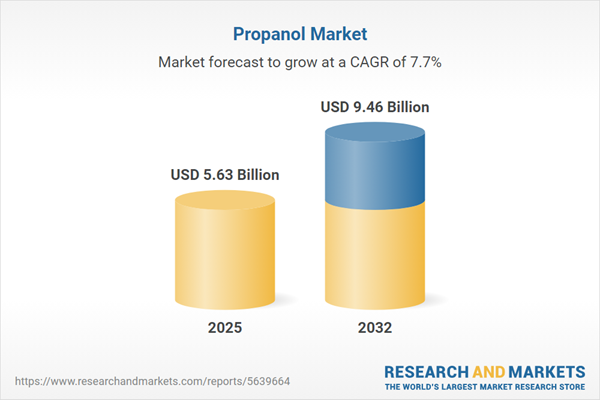Speak directly to the analyst to clarify any post sales queries you may have.
Senior executives navigating the propanol market face rapidly changing regulatory, technological, and sustainability requirements, all of which demand agile adaptation and strategic foresight to maintain operational advantage.
Propanol Market Snapshot: Growth Metrics and Future Outlook
The global propanol market is set for robust growth, projected to increase in value from USD 5.22 billion to USD 9.46 billion by 2032, with a compound annual growth rate (CAGR) of 7.69% between 2024 and 2032. Isopropanol and n-propanol remain vital as solvents, intermediates, and antimicrobial agents serving diverse industries such as pharmaceuticals, personal care, manufacturing, and food processing. The market’s versatility is underscored by its ability to fulfill sophisticated requirements across these sectors. Key regions including North America and Asia-Pacific present ongoing opportunities, although navigating evolving regulatory demands in these markets is essential. As leadership teams consider future resilience, sustainable technology adoption and fortified supply chains remain imperative for ongoing competitiveness.
Scope & Segmentation: Strategic Levers for the Propanol Market
- Application: Critical roles in chemical synthesis, cleaning solvents, detergents, personal care solutions, disinfectants, antiseptics, food and beverage additives, paint and coating production, and pharmaceutical formulations fuel market demand. Propanol’s varied uses support compliance and production quality across these essential verticals.
- Product Type: Isopropanol and n-propanol, supplied in customizable purities, meet the requirements of specialized and broad industrial applications.
- End User Industry: Propanol is integral for automotive, chemicals, oil, food and beverage, pharmaceutical, coatings, and personal care operations, meeting rigorous procurement and regulatory standards to enhance efficiency and safety.
- Purity Grade: Offered in industrial, laboratory, and pharmaceutical grades, propanol fulfills the spectrum from research and development to commercial-scale production, while supporting strict quality assurance protocols.
- Distribution Channel: Sourcing flexibility is achieved through direct supplier contracts, specialist distributors, and digital procurement channels, giving organizations the agility required to respond to market shifts and supply chain risks.
- Region: Major market competition spans North America, Latin America, Europe, the Middle East, Africa, and Asia-Pacific, with distinct regulatory and logistical frameworks in key countries such as the United States, China, India, Germany, Brazil, and South Korea.
- Key Companies: Industry leaders including LyondellBasell Industries N.V., Dow Inc., Shell plc, Exxon Mobil Corporation, INEOS Group Holdings S.A., Saudi Basic Industries Corporation, BASF SE, China Petroleum & Chemical Corporation, Formosa Petrochemical Corporation, and LG Chem, Ltd. focus on ongoing innovation and dependable global supply.
Key Takeaways
- Supporting a complete range of isopropanol and n-propanol requirements empowers organizations to swiftly address changing compliance and market dynamics across multiple geographies.
- Sustainable production methods, especially the advancement of bio-based manufacturing, are gaining significance for organizations seeking to align with new environmental benchmarks and stakeholder values.
- Diversification into new application areas and customer segments supports supply chain flexibility and buffers against shifts in demand, strengthening long-term supplier resilience.
- Mobilizing digital procurement tools and advanced supply chain technologies fosters transparency, improves risk identification, and equips leaders to respond to operational disruptions or regulatory adjustments.
- Adapting approaches to reflect distinctive regulatory and macroeconomic environments in regions such as Asia-Pacific and Europe is critical for sustainable market entry and continuous compliance.
Tariff Impact: Addressing Regulatory Changes in the U.S. Propanol Market
Forthcoming tariff adjustments in the United States in 2025 are driving pharmaceutical and personal care organizations to reassess how they manage imports and exports. Building broader supplier relationships and refining procurement procedures will mitigate the risk of operational disruption due to shifting regulations and maintain continuity in supply chain management.
Methodology & Data Sources
This report derives its findings from comprehensive secondary research, validated regulatory references, and established industry publications. Inputs from procurement analysts and robust market modeling underpin the segmentation and ensure accuracy and reliability throughout the analysis.
The Propanol Market: Why This Report Matters
- Empowers senior leaders with actionable insights into how digitalization and compliance trends are redefining the propanol market landscape.
- Supports the development of agile, resilient operations through informed management of compliance, procurement efficiency, and technology integration.
- Lays the groundwork for sustainable business models prepared to withstand changing industry conditions and regulatory shifts.
Conclusion
Prioritizing compliance, sustainability, and technology-driven procurement strategies enables organizations to effectively align with evolving market realities and build lasting strength within the propanol sector.
Additional Product Information:
- Purchase of this report includes 1 year online access with quarterly updates.
- This report can be updated on request. Please contact our Customer Experience team using the Ask a Question widget on our website.
Table of Contents
3. Executive Summary
4. Market Overview
7. Cumulative Impact of Artificial Intelligence 2025
Companies Mentioned
The companies profiled in this Propanol market report include:- LyondellBasell Industries N.V.
- Dow Inc.
- Shell plc
- Exxon Mobil Corporation
- INEOS Group Holdings S.A.
- Saudi Basic Industries Corporation
- BASF SE
- China Petroleum & Chemical Corporation
- Formosa Petrochemical Corporation
- LG Chem, Ltd.
Table Information
| Report Attribute | Details |
|---|---|
| No. of Pages | 195 |
| Published | October 2025 |
| Forecast Period | 2025 - 2032 |
| Estimated Market Value ( USD | $ 5.63 Billion |
| Forecasted Market Value ( USD | $ 9.46 Billion |
| Compound Annual Growth Rate | 7.6% |
| Regions Covered | Global |
| No. of Companies Mentioned | 11 |









